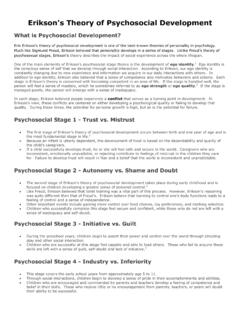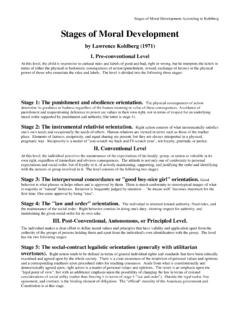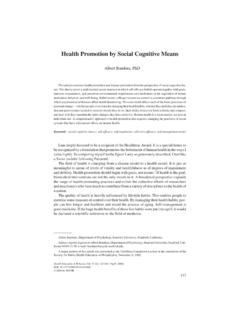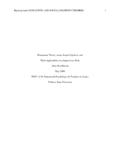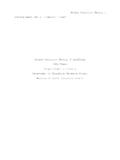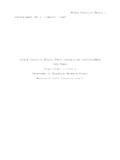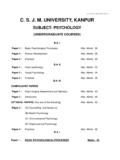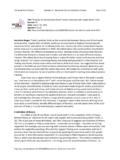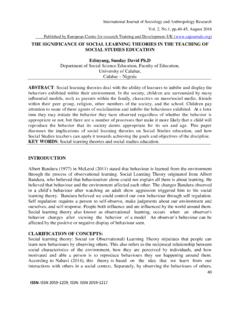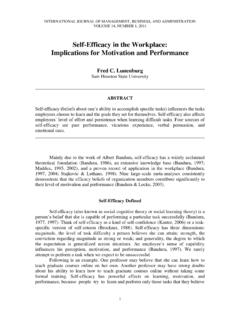Transcription of Social Cognitive Theory Of Learning
1 Social Cognitive Theory 01 Pg. 1 Social Cognitive TheoryOf Learning "Of the many cues that influence behavior, at any point in time, none is more common than the actions of others."( bandura , 1986, )Historical OverviewIn the early 1960 s, when many Learning and instruction theories were being developed, Albert bandura andhis researchers recognized that many overlooked an important aspect of Learning , the observation of others. From this analysis began the Social - Cognitive of Imitation Imitation is an instinct -- Observed actions elicit an instinctive drive to copy those actions. Imitation is limited by development -- Children imitate actions that fit with existing cognitivestructures . Imitation is conditioned -- Behaviors are imitated and reinforced through shaping. Imitationbecomes a generalized response class. Imitation is instrumental behavior -- Imitation becomes a secondary drive through repeatedreinforcement of responses matching those of models.
2 Imitation results in drive 's Social Learning Theory The Social Learning Theory of Julian Rotter represents an integration of Learning and personalitytheories (Phares, 1976). According to Rotter, individuals consider the likely consequences of theiractions in a given situation and act based on their beliefs. The Theory is comprises four major potential refers to the probability that an individual will act in a certain fashionrelative to alternative is the individual's belief concerning the likelihood that a particular reinforcementwill occur as a consequence of a specific value refers to how much the individual values a particular outcome relative toother potential psychological situation implies that the context of behavior is important. The way inwhich the individual views the situation can affect both reinforcement value and expectancy. This relationship is symbolized as follows: BP=E & 's Theory of Social LearningSocial Cognitive Learning Theory highlights the idea that much of human Learning occurs in a socialenvironment.
3 By observing others, people acquire knowledge of rules, skills, strategies, beliefs, andattitudes. Individuals also learn about the usefulness and appropriateness of behaviors by observingmodels and the consequences of modeled behaviors and they act in accordance with their beliefsconcerning the expected outcomes of Cognitive Theory is a direct response to Behaviorism. bandura began building his Theory ofsocial Learning by identifying 3 areas of weakness of limited range of behaviors possible for research in a laboratory type fact that these theories were unable to account for the acquisition of new responses tosituations is dealt with only one type of Learning , , direct Learning , where the learner performs aresponse and experiences the consequences. ( bandura referred to this type of Learning asinstantaneous matching. bandura referred to indirect Learning as delayed matching where thelearner observes reinforced behavior and later enacts the same type of Cognitive Theory 01 Pg.)
4 : Social Cognitive Theory defines Learning as an internal mental process that may or may not be reflected inimmediate behavioral change ( bandura , 1986). / Basic Principles1. People learn by observing others: Modeling (3 types of modeling).Generally, Cognitive modeling involves modeled demonstrations, together with verbal descriptions ofthe model's thoughts and Learning is is goal-directed are 3 types of reinforcers of behaviors: reinforcement -- Direct reinforcement would be directly experienced by the reinforcement -- Vicarious reinforcement would be observed to be consequences of thebehavior of the reinforcement -- Self reinforcement would be feelings of satisfaction or displeasure forbehavior gauged by personal performance behavior is essential to the Learning of behavior is the process of one using one's own thoughts and actions to achieve learners identify goals and adopt and maintain their own strategies for reaching self-regulation, people would not maintain behavior until it could reinforced.
5 **Self-regulations is critical to understanding Soc. Cog. Theory because a lot of human behavioroccurs without immediate reinforcement/punishment. Often, the consequences for behavior are tofar down the road into the future to effect current )4 parts to Self-regulated settingCritical to self-regulated behavior because they help to establish a purpose for one's actionsand provide a means of measuring one's goals have been set, learners monitor themselves to determine their progress. Self-monitoring behavior can be taught in a variety of ways.**Often used as a means of don't necessarily have to be the only one's doing assessment; students can be taughtself-assessment skills. ** Time consuming -- students need to make sure that their goals arespecific and quantitative in nature (ex. running). tend to feel good about the things we accomplish and regretful or guilty about the thingswe don't accomplish.
6 The point is that as individual's become more self-regulated, they learnto reinforce and punish themselves. Often, self-reinforcers and self-punishers are one'sfeelings -- the most powerful form of self-reinforcement is the feeling of accomplishment aftersuccessfully setting and meeting challenging Causation/DeterminationLearning involves the interaction of several factors, such as behavior, environment, storinginformation in memory and personal factors ( , beliefs & expectations: , relevant to ability). Such interactive effects are considered "mutually influencing" -- usually referred to as reciprocalSocial Cognitive Theory 01 Pg. 3causation / determination. For bandura , it is through the observations of models that anindividual's perceptions and actions influence their Cognitive development. Ex.:You get a low score on an algebra test (environmental factor) which influences your belief (personal factor) about your ability to do algebra.
7 Your belief, in turn, influences yourbehavior -- in this case, it's your study habits -- and your behavior influences the environment-- in this case, you got a tutor to help you -vs- Direct Effects of Reinforcement & Punishment on Learning learningEnactive Learning involves Learning from the consequences of one's actions. Behaviors that resultin successful consequences are retained; those that lead to failures are refined or Vicarious ExperiencesOccurs when people observe the consequences of another person's actions and adjust their ownbehavior accordingly. Vicarious sources accelerate Learning over what would be possible if peoplehad to perform every behavior for Learning to occur. Vicarious sources also save people frompersonally experiencing negative types: Vicarious reinforcement & Vicarious behaviorist, punishment & reinforcement are direct causes of behavior; however, for socialcognitive theorists, reinforcement and punishment cause individuals to form expectations aboutconsequences that are likely to result from various behaviors.
8 Ex.:If you study well and do well on a test, you expect to do well on a second test with a similaramount of study. If you see someone else being reinforced for a given behavior, youexpect to reinforced for a similar behavior.**Reinforcement and punishment only changes behavior when learners know whatbehaviors are being reinforced or punishment.**Implication for teachers: a) specifiy what behaviors will be reinforced so that studentscan adapt their behavior accordingly, & b) learners need feedback so that they can knowwhat behaviors have resulted in desirable ProcessingHow we process information when we experience the reinforcement/punishment directly vsindirectly can be quite of reinforcement and punishment from an emotional perspective. E. Choice of BehaviorWe can choose how to respond to a given situation based on the consequences we see of Expected ConsequencesWhen we see the consequences experienced by others, we tend to expect similar consequences ifwe behave in a similar manner.
9 However, similar behaviors don't always result in similarconsequences. Ex.: Leigh Scott Case Study = different outcomes for similar Cognitive Theory 01 Pg. ProcessesModeling is a general term that refers to behavioral, Cognitive , and affective changes deriving from observingone or more characteristics of models is an important factor in determining the degree to which the attention is paid tothe model by the learner. The response of the learner to the modeling behavior is largely determined by three sets of factors: 1.)the particular attributes of the model, such as relevance and credibility for the observer; 2.)the prestige of the model, and 3.)the satisfaction already present in the situation where the behavior is being modeled. A second determinant of the models success is the nature of the observer. Those with a poor sense of selfesteem and those who lack self confidence are more prone to adopt the behavior of models.
10 A. Types of ModelingnSimply attempting to imitate the model's behavior. nLive models include family members, friends, work associates and others with whom theindividual has direct ModelingnImitating behaviors displayed by characters in books, plays, movies, or television..nThe symbolic model is a pictorial representation of Modeling--Developing behaviors by combining portions of observed :A child uses a chair to get up and open the cupboard door after seeing her brother use a chair to geta book from a shelf and seeing her mother open the cupboard Functions of Modeling Response facilitation -- Social prompts create motivational inducements for observers to model theactions ("going along with the crowd"). Models can strengthen existing behaviors. (ex.: standingovation -- we already know the behavior, but when we see others do it, we tend to follow suit). We canalso learn behaviors that we didn't know prior to observing models.
